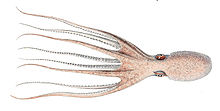- Eledone moschata
-
Eledone moschata 
Scientific classification Kingdom: Animalia Phylum: Mollusca Class: Cephalopoda Order: Octopoda Family: Octopodidae Genus: Eledone Species: E. moschata Binomial name Eledone moschata
(Lamarck, 1798) [1]Synonyms [2] - Octopus moschatus Lamarck, 1798
- Octopus moschites Carus, 1824
- Ozoena moschata (Lamarck, 1798)
- Eledona moschata (Lamarck, 1798)
- Moschites moschatus (Lamarck, 1798)
Eledone moschata, the musky octopus, is a species of octopus that lives in the Mediterranean Sea. It grows up to 740 mm (29 in) long, and feeds on a wide range of crustaceans, molluscs and fish.
Contents
Distribution
Eledone moschata is found throughout the Mediterranean Sea, and is occasionally found in adjacent parts of the Atlantic Ocean, around the Gulf of Cadiz and off the coast of Portugal.[3]
Description
The largest recorded musky octopus was a male with a mantle length of 188 millimetres (7.4 in), a total length of 740 mm (29 in) and a mass of 1,414 grams (3.1 lb), caught in the Gulf of İzmir, in the Aegean Sea. It is closely related to the horned octopus, Eledone cirrhosa, but can be distinguished by a number of features; for example, E. moschata has smooth skin and smells of musk, while E. cirrhosa has warty skin and no musky odour.[4]
Ecology
E. moschata feeds on a wide variety of crustaceans, molluscs and fish. Crustaceans are preferred, and species known to be eaten by E. moschata include Maja squinado, Maja crispata, Macropodia rostrata, Macropodia longirostris, Macropodia rostrata, Pisa tetraodan, Dorippe lanata, Lisa chiragra, Lambrus angulifrons, Lambrus massena, Inachus dorsettensis, Carcinus aestuarii, Pachygrapsus marmoratus, Xantho poressa, Pilumnus hirtellus, Goneplax rhomboides, Pagurus prideauxi, Ilia nucleus and Squilla mantis; molluscs consumed by E., moschata include Clamys varia, Mytilus galloprovincialis, Sepia orbigniyana, Illex coindeti, Loligo subulata; E. moschata also eats the fish Engraulis encrasicolus, Sardina pilchardus, Mullus barbatus, Diplodus annularis, Merluccius merluccius, Merlangius merlangus, Lepidotrigla cavillone, Trachurus trachurus and Trisopterus minutus.[5]
References
- ^ "Eledone moschata (Lamarck, 1798)". Integrated Taxonomic Information System. http://www.itis.gov/servlet/SingleRpt/SingleRpt?search_topic=TSN&search_value=556275.
- ^ "Nomenclatural synthesis of Eledone moschata". CLEMAM: Taxonomic Database on European Marine Mollusca. Muséum National d'Histoire Naturelle. http://www.somali.asso.fr/clemam/biotaxis.php?X=25624&header=1. Retrieved May 27, 2010.
- ^ Alp Salman, Tuncer Katagan, Ali Cemal Gücü (2000). "The distribution and fishing of two Mediterranean Eledone spp. (Octopoda: Cephalopoda) in the Aegean Sea" (PDF). Turkish Journal of Zoology 24: 165–171. http://journals.tubitak.gov.tr/zoology/issues/zoo-00-24-2/zoo-24-2-7-9904-8.pdf.
- ^ W. J. Rees (1956). "Notes on the European species of Eledone with special reference to eggs and larvae". Bulletin of the British Museum (Natural History) Zoology 3: 283–293. http://biostor.org/reference/1306.
- ^ Halil Şen (2007). "Food preference of Eledone moschata Lamarck, 1799 (Cephalopoda: Octopodidae) in captive conditions" (PDF). International Journal of Natural and Engineering Sciences 1 (2): 29–31. http://www.nobel.gen.tr/UserFiles/File/4hsen.pdf.
Categories:- Octopodidae
- Animals described in 1798
Wikimedia Foundation. 2010.

